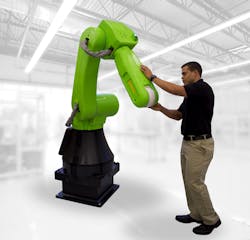New Robots Show Influence of Collaborative Trend
One of the more intriguing automation trends of the past few years has been the rapid development and introduction on new robotics technologies. Much of this trend has been driven by the rise of collaborative capabilities—meaning these robots can work alongside humans rather than in secure areas or cages. This trend seems to be gathering enough speed now to affect both collaborative and non-collaborative robotics—as can seen in the recent introductions of two new robots.
Comau’s new Racer3 robot (see video at end of article), though not outfitted with distinct collaborative robotic capabilities, is clearly influenced by collaborative robotic trends. With a streamlined design and brushed metal exterior, the Racer3 is high-strength aluminum 6-axis articulated robot that is not meant to be operated out of sight or in a cage. This 66 lb. robot can be mounted on benches, walls, ceilings or on inclined supports. According to Comau, the robot was designed for use in general industry sectors, such as food & beverage, electronics, plastics, and metalworking by small to mid-sized companies looking to automate their operations.
Beyond its small footprint and light weight, Racer3’s flexibility and speed are two other specific areas Comau is highlighting. In its release announcing the new robot, Comau says, “Racer3 is a natural contortionist that can bend like a snake until it assumes the shape of a scissor, surpassing the flange at axis 1. Or, it can close like a book, bringing the wrist toward the body to rotate the axis 1 at maximum speed while avoiding collisions with anything in the surrounding space…[and] with a cycle time of less than 0.36 seconds for a 1kg pick-and-place cycle, the rigid construction and stable base ensures high precision and repeatability.”
More directly in the collaborative robot field is Fanuc’s CR-35iA (see video at end of article). Most collaborative robots on the market are of the smaller payload variety, but the CR-35iA can reportedly handle payloads up to 77 lbs.—which Fanuc says is an industry first for a collaborative robot. This new robot is outfitted with a soft green foam cover to add further protection to humans working alongside the robot.
According to Fanuc, the CR-35iA meets ISO 10218-1:2011 robotic safety requirements and is designed to work in a variety of applications alongside humans in operations such as machine tending, handling heavy payloads that require lift assist devices or custom equipment, higher payload mechanical assembly, palletizing or packing, and tote or carton handling.
Greg Buell, product manager at Fanuc America says the CR-35iA robot was developed to help manufacturers solve ergonomic challenges by handling applications that are physically demanding for humans, such as heavy lifting. In the automotive industry, for example, workers are required to lift spare tires into vehicles on the assembly line. “The CR-35iA can work alongside the employees assigned to this task to help reduce injuries associated with repetitive or heavy lifting,” he says.
The CR-35iA also supports Fanuc’s iRVision technology for visual part recognition.
See video of Fanuc's CR-35iA
See video of Comau's Racer3


